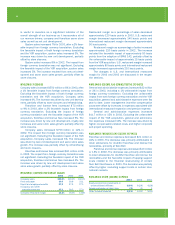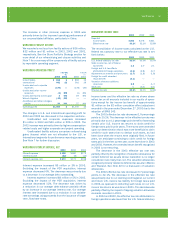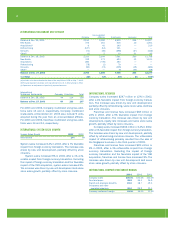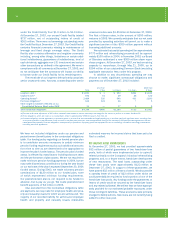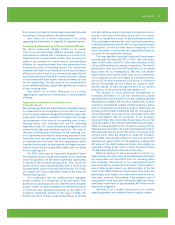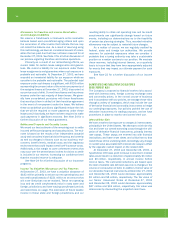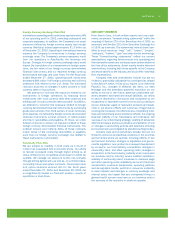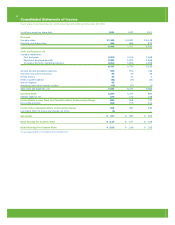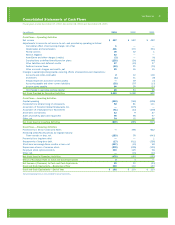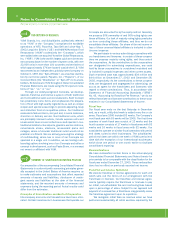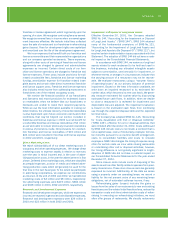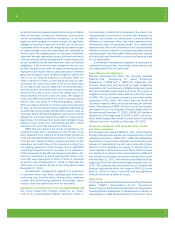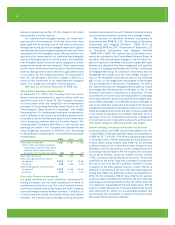Pizza Hut 2003 Annual Report Download - page 48
Download and view the complete annual report
Please find page 48 of the 2003 Pizza Hut annual report below. You can navigate through the pages in the report by either clicking on the pages listed below, or by using the keyword search tool below to find specific information within the annual report.
46.
Allowances for Franchise and License Receivables
and Contingent Liabilities
We reserve a franchisee’s or licensee’s entire receivable
balance based upon pre-defined aging criteria and upon
the occurrence of other events that indicate that we may
not collect the balance due. As a result of reserving using
this methodology, we have an immaterial amount of receiv-
ables that are past due that have not been reserved for at
December 27, 2003. See Note 2 for a further discussion of
our policies regarding franchise and license operations.
Primarily as a result of our refranchising efforts, we
remain liable for certain lease assignments and guaran-
tees. We record a liability for our exposure under these
lease assignments and guarantees when such exposure is
probable and estimable. At December 27, 2003, we have
recorded an immaterial liability for our exposure which we
consider to be probable and estimable. The potential total
exposure under such leases is significant, with $326 million
representing the present value of the minimum payments of
the assigned leases at December 27, 2003, discounted at
our pre-tax cost of debt. Current franchisees are the primary
lessees under the vast majority of these leases. We gener-
ally have cross-default provisions with these franchisees
that would put them in default of their franchise agreement
in the event of non-payment under the lease. We believe
these cross-default provisions significantly reduce the risk
that we will be required to make payments under these
leases and, historically, we have not been required to make
such payments in significant amounts. See Note 24 for a
further discussion of our lease guarantees.
Self-Insured Property and Casualty Losses
We record our best estimate of the remaining cost to settle
incurred self-insured property and casualty claims. The esti-
mate is based on the results of an independent actuarial
study and considers historical claim frequency and severity
as well as changes in factors such as our business envi-
ronment, benefit levels, medical costs and the regulatory
environment that could impact overall self-insurance costs.
Additionally, a risk margin to cover unforeseen events that
may occur over the several years it takes for claims to settle
is included in our reserve, increasing our confidence level
that the recorded reserve is adequate.
See Note 24 for a further discussion of our insurance
programs.
Income Tax Valuation Allowances and Tax Reserves
At December 27, 2003, we have a valuation allowance of
$183 million primarily to reduce our net operating loss and
tax credit carryforwards of $231 million to an amount that
will more likely than not be realized. These net operating
loss and tax credit carryforwards exist in many state and
foreign jurisdictions and have varying carryforward periods
and restrictions on usage. The estimation of future taxable
income in these state and foreign jurisdictions and our
resulting ability to utilize net operating loss and tax credit
carryforwards can significantly change based on future
events, including our determinations as to the feasibility
of certain tax planning strategies. Thus, recorded valuation
allowances may be subject to material future changes.
As a matter of course, we are regularly audited by
federal, state and foreign tax authorities. We provide
reserves for potential exposures when we consider it
probable that a taxing authority may take a sustainable
position on a matter contrary to our position. We evaluate
these reserves, including interest thereon, on a quarterly
basis to insure that they have been appropriately adjusted
for events that may impact our ultimate payment for such
exposures.
See Note 22 for a further discussion of our income
taxes.
QUANTITATIVE AND QUALITATIVE DISCLOSURES
ABOUT MARKET RISK
The Company is exposed to financial market risks associ-
ated with interest rates, foreign currency exchange rates
and commodity prices. In the normal course of business
and in accordance with our policies, we manage these risks
through a variety of strategies, which may include the use
of derivative financial and commodity instruments to hedge
our underlying exposures. Our policies prohibit the use of
derivative instruments for trading purposes, and we have
procedures in place to monitor and control their use.
Interest Rate Risk
We have a market risk exposure to changes in interest rates,
principally in the United States. We attempt to minimize this
risk and lower our overall borrowing costs through the utili-
zation of derivative financial instruments, primarily interest
rate swaps. These swaps are entered into with financial
institutions and have reset dates and critical terms that
match those of the underlying debt. Accordingly, any change
in market value associated with interest rate swaps is offset
by the opposite market impact on the related debt.
At December 27, 2003 and December 28, 2002, a
hypothetical 100 basis point increase in short-term interest
rates would result in a reduction of approximately $3 million
and $6 million, respectively, in annual income before
income taxes. The estimated reductions are based upon
the level of variable rate debt and assume no changes in the
volume or composition of debt. In addition, the fair value of
our derivative financial instruments at December 27, 2003
and December 28, 2002 would decrease approximately
$5 million and $8 million, respectively. The fair value of
our Senior Unsecured Notes at December 27, 2003
and December 28, 2002 would decrease approximately
$87 million and $93 million, respectively. Fair value was
determined by discounting the projected cash flows.


